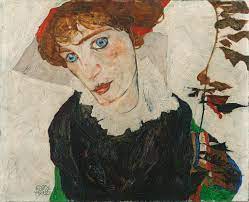News:
US lawsuit to confiscate Schiele's Portrait of Wally suspended
By Martha Lufkin
Judgement has been postponed to allow the government to review new evidence

Schiele's Portrait of Wally
BOSTON. Judgement on a long-running lawsuit in New York which helped launch a world outcry over Nazi-looted art at museums and prompted many institutions to begin examining their collections for history of Nazi theft, has been postponed to let the US government review new evidence. On 3 June the schedule was suspended on a case brought by the US government in 1999 to seek confiscation of Egon Schiele's Portrait of Wally from the Leopold Museum in Vienna, under the US National Stolen Property Act. The US says the Leopold knew that the art was stolen by a Nazi in 1939 from its Jewish owner, Lea Bondi. The case, which the parties had asked the court to resolve without a trial, is before the federal district court in Manhattan.
In October 1997, the Leopold sent over 150 works by Austrian expressionist Egon Schiele on an ill-fated journey to the Museum of Modern Art (MoMA) in New York, exposing the collection, built by the museum's museological director Rudolph Leopold, to the New York public and US courts. Soon after the Schiele show opened, allegations were voiced linking two works to Nazi looting. After a subpoena by the New York district attorney failed to detain the two works for a stolen property investigation, the US government commenced the current confiscation suit for Wally in 1999. the work is currently being held by the US government.
The lawsuits evoked criticism at the time that the government was interfering with informational art loans, but are now often cited as having helped urge museums to re-examine the Nazi-era history of their art.
In a court memorandum filed in March, the government presented its case, joined by the Bondi estate, which will receive the painting if it is forfeited. According to the US, in 1939 Nazi art dealer Friedrich Welz come to Bondi's apartment in Vienna, and pressured her to give him the painting. Bondi let him have it, the US says, urged by her husband that the couple wanted to flee the next day and because "you know what the man could do."
Because of an error by US Forces after the war, which misclassified the painting as the property of Dr Heinrich Rieger, who died at Theresienstadt concentration camp, the painting ended up at the Austrian National Gallery (ANG), which bought Dr Rieger's collection from his heirs. Despite being alerted by US Forces to Wally's mix-up with the Rieger art, the Austrian National Gallery "wrongfully took Wally for itself," knowing it was not Rieger's, the US says.
Dr Leopold, despite being asked by Bondi in 1953 to help her get the painting back from the ANG, acquired it for himself from the institution in 1954, the US says. Bondi visited the museum and claimed the painting, the US says.
Neither the ANG nor Dr Leopold, the US says, had the requisite degree of "confidence" in their ownership to gain title by "prescriptive possession" under Austrian law, which requires that property be held for six years with belief that the possession is lawful. Instead, based on the evidence that each had at the time, both the ANG and Dr Leopold had ample objective reason to doubt their ownership, the US says.
Dr Leopold evidenced his guilty knowledge that the art was stolen when he published a 1995 catalogue on Schiele inserting a "false provenance" that Rieger had owned the painting, the US says.
But the Leopold Museum is equally arguing that it owns the painting. In its June court filing, it cites facts to revive its prior argument that the portrait ceased to be "stolen" when US Forces recovered it in 1947. The US recovery, and the US return of the painting to the Austrian government for return to its lawful owner, removed any alleged "stolen" taint before it passed to the ANG and Dr Leopold, the museum says. In addition, the museum says that the "total and unbroken silence" of Lea Bondi and her heirs about the claim, from 1957 until 1997, has resulted in unreasonable delay and the deaths of nine key witnesses, which would "unduly prejudice" the museum in defending the suit.
Bondi was urged by her lawyer and friends to bring a claim, but she and her heirs did not because of uncertainties of the result, the Leopold claims. The museum also argues that Dr Leopold had the needed confidence in his ownership to gain title to the painting under Austrian law. He was never informed "of any assertion" that the painting was taken by theft from Bondi, "much less by a Nazi or even during the Nazi era," the museum says, and Bondi "never gave Leopold the factual details of her purported claim. After Leopold arranged an appointment for Bondi with the director of the ANG to present her claim, the museum says, she failed to appear, then met twice with the director "without ever mentioning the painting."
In 1954, Bondi told Leopold "that she had decided to drop the matter," the museum says. "There simply is no evidence from which to conclude that Leopold knew" when he bought the painting that Bondi really owned it, and that the ANG did not, the Leopold says.
But the US says Bondi's lawyers "wrote multiple letters to Leopold regarding her claim." She never filed suit, the government says, because she believed she could not defeat Dr Leopold in Austria, and understood that "legal actions taken by Jews who had fled Austria" were "almost always unsuccessful."
http://www.theartnewspaper.com/article.asp?id=16693


